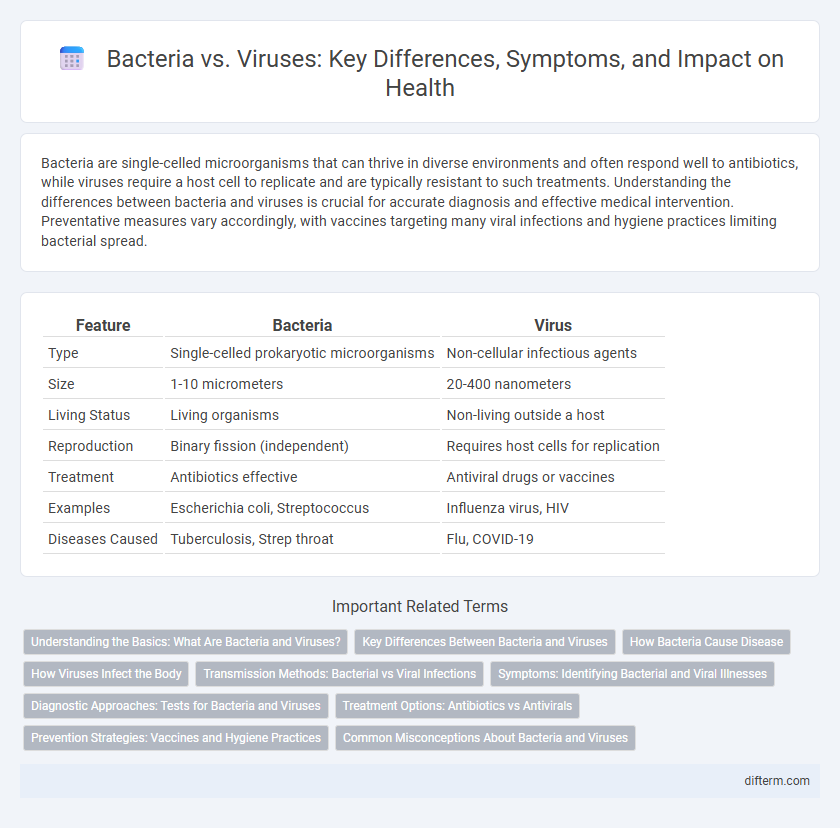Bacteria are single-celled microorganisms that can thrive in diverse environments and often respond well to antibiotics, while viruses require a host cell to replicate and are typically resistant to such treatments. Understanding the differences between bacteria and viruses is crucial for accurate diagnosis and effective medical intervention. Preventative measures vary accordingly, with vaccines targeting many viral infections and hygiene practices limiting bacterial spread.
Table of Comparison
| Feature | Bacteria | Virus |
|---|---|---|
| Type | Single-celled prokaryotic microorganisms | Non-cellular infectious agents |
| Size | 1-10 micrometers | 20-400 nanometers |
| Living Status | Living organisms | Non-living outside a host |
| Reproduction | Binary fission (independent) | Requires host cells for replication |
| Treatment | Antibiotics effective | Antiviral drugs or vaccines |
| Examples | Escherichia coli, Streptococcus | Influenza virus, HIV |
| Diseases Caused | Tuberculosis, Strep throat | Flu, COVID-19 |
Understanding the Basics: What Are Bacteria and Viruses?
Bacteria are single-celled microorganisms that can live independently and reproduce on their own, often beneficial or harmless but sometimes causing infections like strep throat or tuberculosis. Viruses are smaller infectious agents requiring a host cell to replicate, responsible for diseases such as influenza, HIV, and COVID-19. Understanding the structural and functional differences between bacteria and viruses is crucial for effective diagnosis, treatment, and prevention strategies in healthcare.
Key Differences Between Bacteria and Viruses
Bacteria are single-celled microorganisms capable of independent reproduction and metabolism, while viruses require a host cell to replicate, lacking cellular structures and metabolic functions. Bacteria can be treated with antibiotics, whereas viruses respond primarily to antiviral medications and vaccines due to their distinct biological makeup. The size difference is significant, with bacteria generally much larger than viruses, influencing their modes of infection and immune system interactions.
How Bacteria Cause Disease
Bacteria cause disease by invading host tissues and releasing toxins that damage cells and disrupt normal bodily functions. They multiply rapidly, overwhelming the immune system and leading to infections such as strep throat, tuberculosis, and urinary tract infections. Some bacteria form biofilms, enhancing their resistance to antibiotics and complicating treatment.
How Viruses Infect the Body
Viruses infect the body by attaching to specific host cells and injecting their genetic material, which takes over the cell's machinery to replicate viral particles. Unlike bacteria, viruses cannot reproduce independently and rely entirely on hijacking living cells to multiply and spread infection. This process often damages or destroys the host cells, triggering immune responses and symptoms of viral illnesses.
Transmission Methods: Bacterial vs Viral Infections
Bacterial infections commonly transmit through direct contact, respiratory droplets, contaminated food, or surfaces, while viral infections spread primarily via airborne droplets, bodily fluids, and surfaces contaminated with viral particles. Bacteria can reproduce independently, often localized to a specific infection site, whereas viruses require host cells to replicate, facilitating rapid systemic spread. Understanding these distinct transmission methods is crucial for effective infection control and targeted treatment strategies.
Symptoms: Identifying Bacterial and Viral Illnesses
Bacterial infections often cause localized symptoms such as redness, swelling, and pus formation, while viral illnesses typically present with systemic symptoms like fever, fatigue, and body aches. Distinguishing between bacteria and viruses relies on symptom patterns; bacterial infections may lead to high fever and persistent coughing, whereas viral infections frequently result in runny nose, sore throat, and sneezing. Accurate diagnosis depends on recognizing these symptom differences alongside laboratory tests such as cultures and PCR to confirm the underlying pathogen.
Diagnostic Approaches: Tests for Bacteria and Viruses
Diagnostic approaches for bacteria typically involve culture tests, gram staining, and biochemical assays to identify specific bacterial strains, while viral infections are commonly diagnosed through polymerase chain reaction (PCR), antigen detection, and serological tests measuring antibodies. Bacterial cultures provide precise antibiotic sensitivity profiles, whereas viral PCR tests rapidly detect viral genetic material with high specificity and sensitivity. Accurate differentiation through these tests is critical for guiding effective treatment plans and preventing antimicrobial resistance.
Treatment Options: Antibiotics vs Antivirals
Antibiotics effectively target bacterial infections by killing or inhibiting bacterial growth, but they are ineffective against viruses. Antiviral medications specifically disrupt viral replication processes, reducing the severity and duration of viral illnesses like influenza and herpes. Proper diagnosis is crucial to determine the appropriate treatment, as misuse of antibiotics can lead to antibiotic resistance, while timely antiviral therapy improves patient outcomes in viral infections.
Prevention Strategies: Vaccines and Hygiene Practices
Vaccines are essential in preventing viral infections such as influenza and measles by stimulating the immune system to recognize and fight specific viruses. Maintaining hygiene practices like regular handwashing, sanitizing surfaces, and using masks reduces the transmission of both bacteria and viruses, effectively lowering infection rates. Combining vaccination programs with consistent hygiene habits enhances community health resilience against contagious diseases.
Common Misconceptions About Bacteria and Viruses
Bacteria and viruses are often confused, but bacteria are living organisms that can reproduce on their own, while viruses require a host cell to multiply. Many people mistakenly believe antibiotics treat viruses; however, antibiotics are effective only against bacterial infections. Misunderstanding these distinctions can lead to improper treatment and antibiotic resistance, posing significant public health risks.
Bacteria vs Virus Infographic

 difterm.com
difterm.com